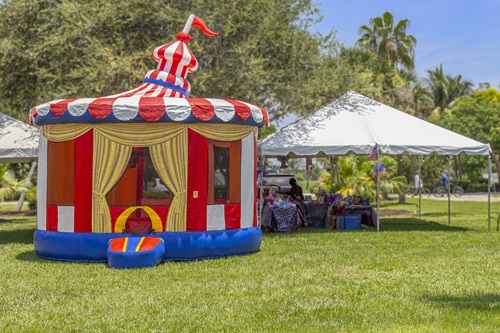
A bounce house at a Minor League Baseball game in Maryland took flight in a sudden wind and was sent 15 to 20 feet into the air, killing one child, injuring another and rattling parents nationwide.
According to USA TODAY, the tragedy unfolded on Friday, August 2 at Regency Furniture Stadium in Waldorf, about 56 miles south of Baltimore, where the Southern Maryland Blue Crabs baseball team was playing. The two children were inside the bounce house when the event took place and were thrown out in midair before the structure landed onto the playing field, according to a press release from Charles County.
Emergency personnel who were stationed at the stadium for the game, trainers from the baseball team and volunteer first responders in attendance all began administering medical care, and both children were transported to an area hospital; one was declared dead and the other had non-life-threatening injuries.
“We extend our deepest empathy to the children and their families during this difficult time,” said Reuben B. Collins II Esq., the Charles County Government commissioner president, in a statement. “We thank our EMS team and the Maryland State Police for their swift actions to ensure the children received immediate care.”
Bounce houses, variously known as bouncy houses and moon bounces, are summertime staples at ballgames, tailgate parties and even expos for sports events. Unfortunately, they carry a high degree of catastrophic (and high-profile) risk, as news reports show.
In fact, notes KOAT Action News, it wasn’t that long ago that five teenagers were injured in Washington State when a bounce house tipped over when wind gusts tore into it in 2019. Six children were killed in Australia in 2021. And a two-year-old lost his life in a Nebraska accident in 2018.
 In some cases, users slam into one another while bouncing, causing everything from concussions to facial injuries to broken bones. And while bounce houses have caused plenty of injuries without the help of wind, most of the wind-related incidents were head and neck injuries due to kids falling out of the bounce house when it was moved by wind, John Knox, Ph.D., a professor and researcher at the University of Georgia, told reporters at USA TODAY.
In some cases, users slam into one another while bouncing, causing everything from concussions to facial injuries to broken bones. And while bounce houses have caused plenty of injuries without the help of wind, most of the wind-related incidents were head and neck injuries due to kids falling out of the bounce house when it was moved by wind, John Knox, Ph.D., a professor and researcher at the University of Georgia, told reporters at USA TODAY.
In fact, the statistics are downright sobering. Two-thirds of the injuries are to legs and arms. Fifteen percent involve heads and faces. And a study published in the journal, Pediatrics, reported that in 2010, a child got hurt on a moon bounce every 46 minutes.
According to the Washington Post, a report from the Consumer Product Safety Commission states that 82,203 people were injured on or in inflatables between 2008 and 2013, more than 90 percent of those on moon bounces. (That number represents ER visits and doesn't include scrapes and bruises dealt with at home.) And the rate of injuries has been growing over time, perhaps because moon bounces, also called bounce houses, are more common than ever, with even backyard versions available for parties.
Unfortunately, states have yet to regulate inflatable structures of any kind.
"There's always an issue for injuries,” Herman Shorty told reporters at KOAT. Shorty is who is one of a handful of inspectors who examines every legally operated bounce house in New Mexico. And, he notes, not everyone is getting inspections. He says there are companies that operate all over his state without a license. And it's hard to know how many are out there. In fact, he notes, "There's no nobody collecting the data that would be specific to how many operators there are, or how many of those operators are abiding in compliance with the requirements for the state.”
And inflatables rented for home use, such as during birthday parties, neighborhood gatherings or block parties, can have just as many bad consequences. Three children in El Paso, Texas, were injured when a dust devil (that’s a windstorm for those not in the southwest) picked up a bounce house and sent it flying above several other houses in the neighborhood.
An inflatable structure in Pasadena, California, was blown around during Rose Bowl festivities, injuring many; another inflatable blew onto a highway in Adelanto, California with one child inside, hurting the child and causing an automobile crash. And in Reno, Nevada, when winds lifted up an inflatable castle with three children inside, it was driven into electrical power lines, injuring two of the kids and killing the third.
 Dr. Terri Cappello, a pediatric orthopedic surgeon at Shriners Children’s Hospital in Chicago, told reporters at USA TODAY that not a single summer has passed in her career where she did not have to treat a broken bone due to a bounce house injury.
Dr. Terri Cappello, a pediatric orthopedic surgeon at Shriners Children’s Hospital in Chicago, told reporters at USA TODAY that not a single summer has passed in her career where she did not have to treat a broken bone due to a bounce house injury.
While insurance companies and doctors recommend that only one child be allowed into inflatable structures at a time, that advice is largely ignored.
Having insurance is essential but many may overlook what is (and is not) covered in current policies.
"For most sports, General Liability policies have exclusions for the use of inflatables," notes John Sadler, president of Sadler Sports & Recreation Insurance. "Therefore, the sports organization should be sure to collect a currently valid certificate of insurance from the inflatable vendor with an each occurrence limit of at least $1M and with additional insured status. An indemnification/hold harmless provision in favor of the sports organization would be advisable as well."
Many rental companies for inflatables have developed rules and safety guidelines but, as previously noted, there is no way to know whether people are taking out insurance, or whether the guidelines are being followed.
Unless, that is, something unfortunate, or even tragic, happens.

